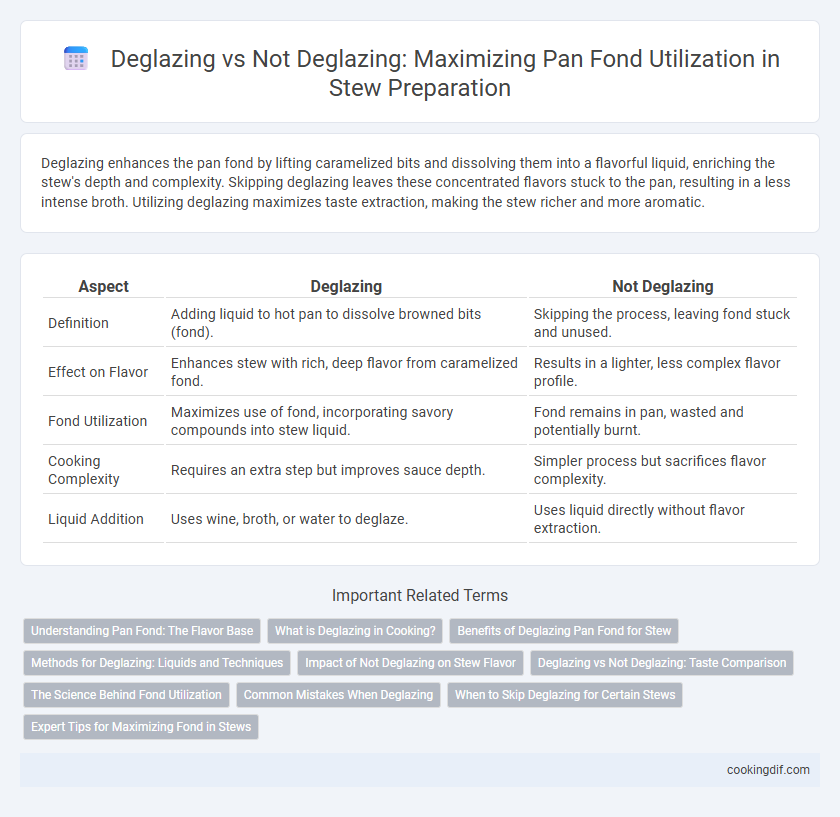Deglazing enhances the pan fond by lifting caramelized bits and dissolving them into a flavorful liquid, enriching the stew's depth and complexity. Skipping deglazing leaves these concentrated flavors stuck to the pan, resulting in a less intense broth. Utilizing deglazing maximizes taste extraction, making the stew richer and more aromatic.
Table of Comparison
| Aspect | Deglazing | Not Deglazing |
|---|---|---|
| Definition | Adding liquid to hot pan to dissolve browned bits (fond). | Skipping the process, leaving fond stuck and unused. |
| Effect on Flavor | Enhances stew with rich, deep flavor from caramelized fond. | Results in a lighter, less complex flavor profile. |
| Fond Utilization | Maximizes use of fond, incorporating savory compounds into stew liquid. | Fond remains in pan, wasted and potentially burnt. |
| Cooking Complexity | Requires an extra step but improves sauce depth. | Simpler process but sacrifices flavor complexity. |
| Liquid Addition | Uses wine, broth, or water to deglaze. | Uses liquid directly without flavor extraction. |
Understanding Pan Fond: The Flavor Base
Deglazing is essential for unlocking the rich flavor trapped in the pan fond, the browned bits left after sauteing meat or vegetables that serve as a concentrated flavor base for stews and sauces. Without deglazing, the fond remains stuck and can burn, preventing the release of these deeply savory, caramelized compounds that enhance the stew's complexity. Utilizing a liquid such as wine, broth, or vinegar to deglaze dissolves the fond, incorporating its intense umami and depth directly into the cooking liquid, boosting the stew's overall taste profile.
What is Deglazing in Cooking?
Deglazing in cooking involves adding liquid, such as wine or broth, to a hot pan after sauteing or searing ingredients, which loosens and dissolves the browned bits of food residue, known as fond. Utilizing deglazing maximizes the flavor development of a stew by incorporating these caramelized particles back into the sauce, enhancing richness and depth. Skipping deglazing often results in wasted fond stuck to the pan, leading to a less flavorful final dish.
Benefits of Deglazing Pan Fond for Stew
Deglazing pan fond in stew preparation enhances flavor complexity by dissolving caramelized browned bits into the liquid, intensifying taste with rich, savory notes. This technique also helps create a silky texture and balanced consistency by incorporating fond's concentrated juices. Utilizing deglazed fond elevates the stew's depth and aroma, making each bite more robust and satisfying.
Methods for Deglazing: Liquids and Techniques
Deglazing transforms pan fond by dissolving browned bits into flavorful sauces using liquids like wine, broth, or vinegar. Common techniques include pouring the liquid into hot pans immediately after cooking, then scraping with wooden spoons or spatulas to release fond fully. Proper deglazing enhances depth and complexity in stews by incorporating caramelized residues efficiently into the final dish.
Impact of Not Deglazing on Stew Flavor
Not deglazing a pan after browning meat for stew leaves the fond stuck and bitter, significantly reducing the depth and complexity of flavor in the final dish. The caramelized bits contain concentrated savory compounds that dissolve into the liquid during deglazing, enriching the stew's taste and mouthfeel. Skipping this step results in a flatter, less robust stew lacking the signature richness derived from pan fond integration.
Deglazing vs Not Deglazing: Taste Comparison
Deglazing a pan by adding liquid after searing meat dissolves the browned fond, enhancing flavor complexity and creating a rich, caramelized sauce. Without deglazing, the fond remains stuck and can burn, resulting in a bitter taste and lost depth in the stew. The deglazing technique intensifies the umami profile, elevating overall taste and mouthfeel compared to not deglazing.
The Science Behind Fond Utilization
Deglazing unlocks the complex flavors trapped in pan fond by dissolving browned food residues with liquid, releasing amino acids and sugars that create a rich, savory base for sauces. Without deglazing, fond remains stuck to the pan, limiting its flavor extraction and resulting in less depth in the final dish. The Maillard reaction during cooking forms the fond, but liquid deglazing is essential to transfer these concentrated flavor compounds into the sauce effectively.
Common Mistakes When Deglazing
Common mistakes when deglazing include using excessive liquid, which dilutes the concentrated flavors of the pan fond, and adding the liquid to a cold pan, preventing proper flavor extraction. Failing to scrape the browned bits thoroughly can result in losing the rich, caramelized essence essential for stews. Overheating after adding the liquid may cause bitterness, compromising the depth of the sauce or stew base.
When to Skip Deglazing for Certain Stews
Skipping deglazing in stew preparation is advisable when the fond is lightly browned or minimal, as excessive scraping can introduce bitterness and cloud the broth. When using delicate ingredients like vegetables or seafood, avoiding deglazing preserves the subtle flavors without overpowering the stew. In slow-cooked stews with long simmering times, the fond naturally dissolves into the liquid, making deglazing unnecessary and simplifying the cooking process.
Expert Tips for Maximizing Fond in Stews
Deglazing the pan with a liquid such as wine or broth immediately after browning meat lifts the fond, dissolving caramelized bits into the stew and intensifying flavor complexity. Skipping deglazing leaves the fond stuck and can result in a less rich base, but carefully scraping the fond during cooking offers a subtler taste enhancement. Expert chefs recommend deglazing to maximize fond utilization, as it unlocks deep umami notes critical for gourmet stew profiles.
Deglazing vs not deglazing for pan fond utilization Infographic

 cookingdif.com
cookingdif.com